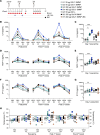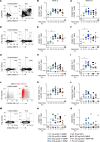The saponin monophosphoryl lipid A nanoparticle adjuvant induces dose-dependent HIV vaccine responses in nonhuman primates
- PMID: 40036068
- PMCID: PMC11996878
- DOI: 10.1172/JCI185292
The saponin monophosphoryl lipid A nanoparticle adjuvant induces dose-dependent HIV vaccine responses in nonhuman primates
Abstract
Induction of durable protective immune responses is the main goal of prophylactic vaccines, and adjuvants play a role as drivers of such responses. Despite advances in vaccine strategies, development of a safe and effective HIV vaccine remains a significant challenge. Use of an appropriate adjuvant is crucial to the success of HIV vaccines. Here we assessed the saponin/MPLA nanoparticle (SMNP) adjuvant with an HIV envelope (Env) trimer, evaluating the safety and effect of multiple variables - including adjuvant dose (16-fold dose range), immunization route, and adjuvant composition - on the establishment of Env-specific memory T and B cell (TMem and BMem) responses and long-lived plasma cells in nonhuman primates (NHPs). Robust BMem were detected in all groups, but a 6-fold increase was observed in the highest- versus the lowest-SMNP-dose group. Similarly, stronger vaccine responses were induced by the highest SMNP dose in CD40L+OX40+ CD4+ TMem (11-fold), IFN-γ+ CD4+ TMem (15-fold), IL21+ CD4+ TMem (9-fold), circulating T follicular helper cells (TFH; 3.6-fold), BM plasma cells (7-fold), and binding IgG (1.3-fold). Substantial tier 2 neutralizing antibodies were only observed in the higher-SMNP-dose groups. These investigations highlight the dose-dependent potency of SMNP and its relevance for human use and next-generation vaccines.
Keywords: AIDS vaccine; AIDS/HIV; Adaptive immunity; Immunology.
Figures






Update of
-
Dose-dependent regulation of immune memory responses against HIV by saponin monophosphoryl lipid A nanoparticle adjuvant.bioRxiv [Preprint]. 2024 Aug 3:2024.07.31.604373. doi: 10.1101/2024.07.31.604373. bioRxiv. 2024. Update in: J Clin Invest. 2025 Mar 4;135(8):e185292. doi: 10.1172/JCI185292. PMID: 39211109 Free PMC article. Updated. Preprint.
References
-
- Singh A, et al. Optimizing the immunogenicity of HIV vaccines by adjuvants - NIAID workshop report. Vaccine. 2023;41(31):4439–4446. - PubMed
MeSH terms
Substances
Grants and funding
LinkOut - more resources
Full Text Sources
Medical
Research Materials

